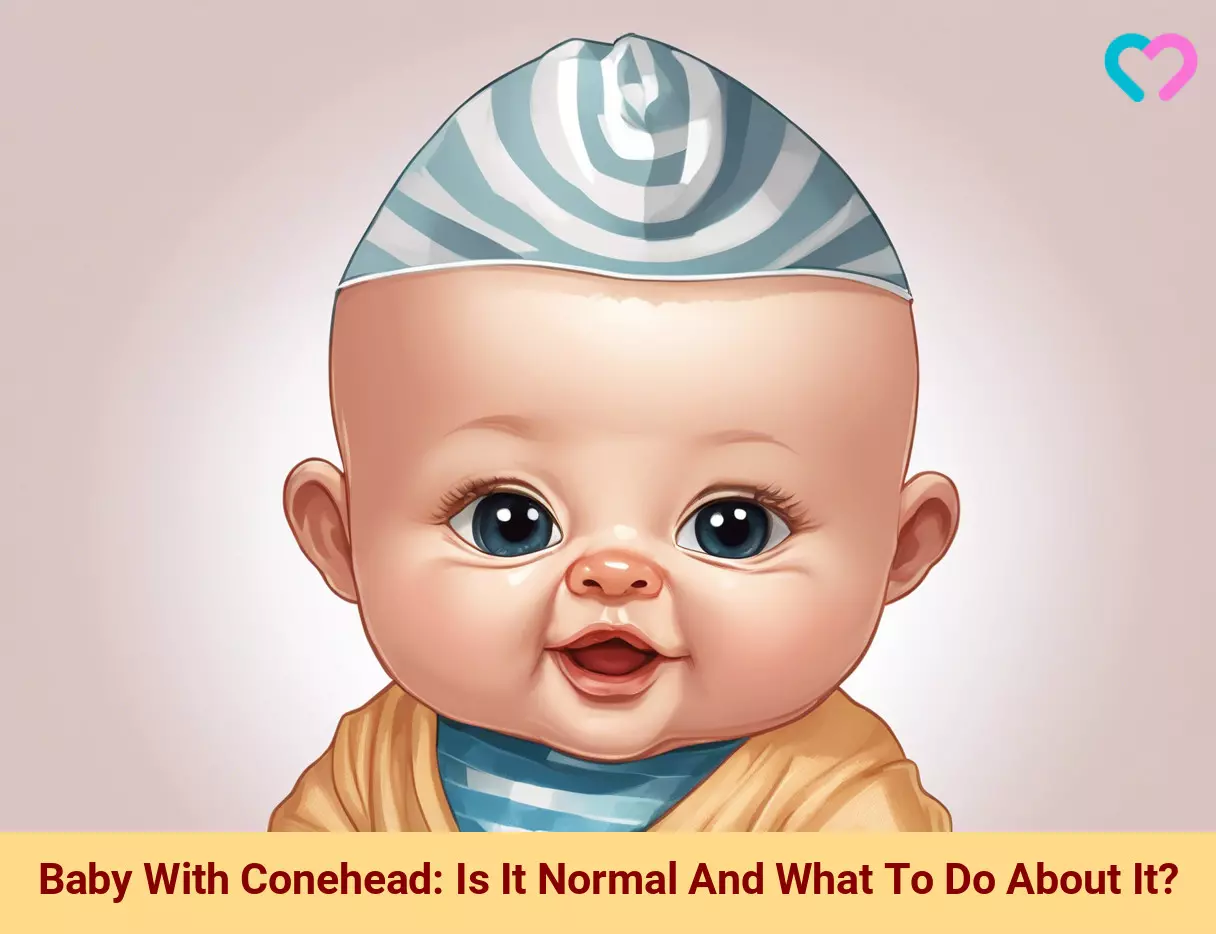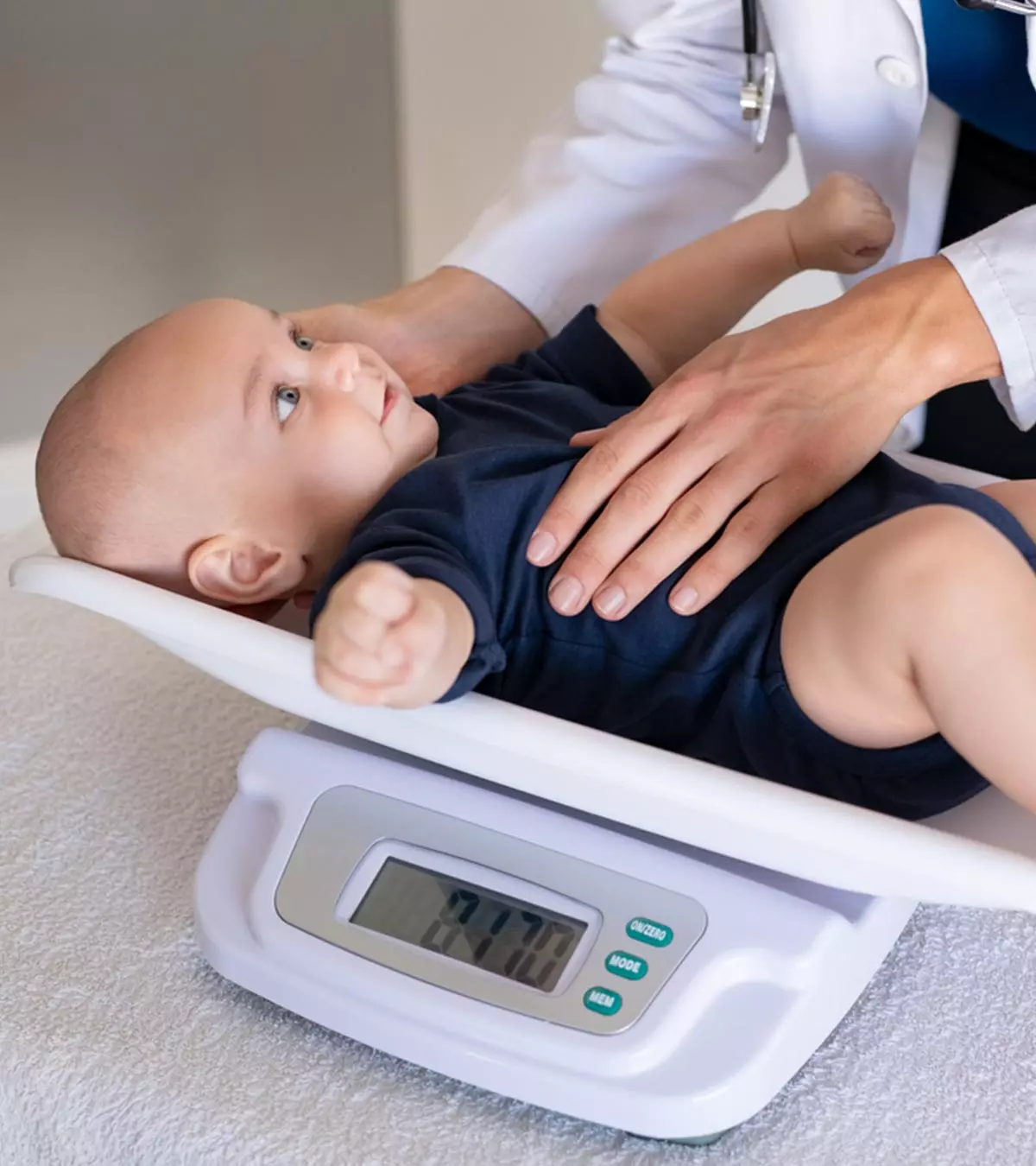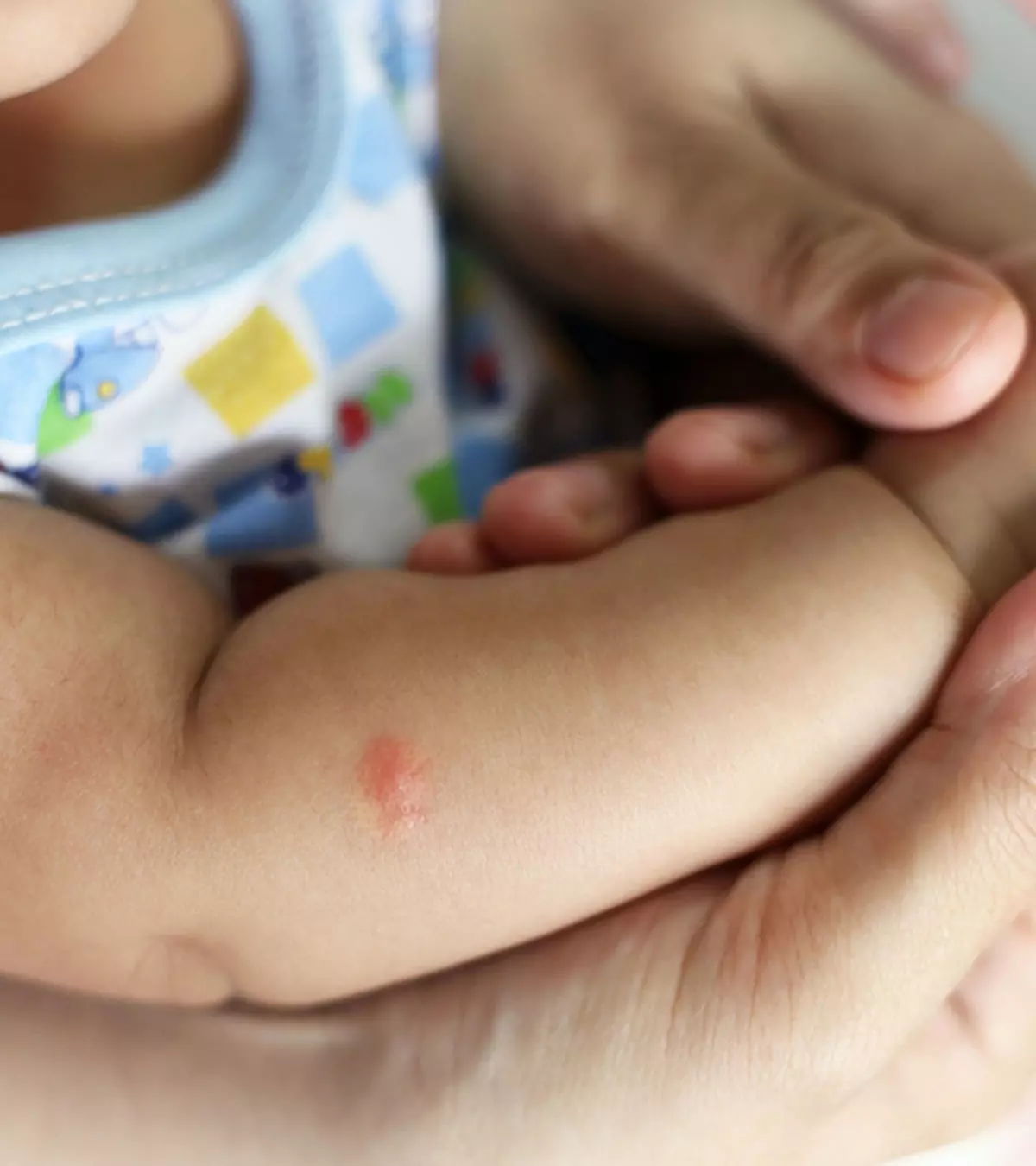
Image: ShutterStock
A conehead baby is born with a cone-shaped head after vaginal birth. During vaginal birth, babies pass through a tight birth canal, where their malleable head bones get squeezed to make their way out. During this time, their head may develop a cone-like shape.

For many babies, their heads return to their normal shape within 48 hours after birth. In others, a few days or weeks may be required, but the need for medical intervention is rare. However, consult your pediatrician if your baby has head shape abnormalities that appear severe.
Read this post to know more about the causes of a conehead in babies, the concerns it may raise, and when to worry about it.
Key Pointers
- Squeezing the baby’s skull bones through the birth canal during vaginal birth might lead to a baby with a conehead.
- Conehead after vaginal birth is normal and resolves within a few weeks.
- Babies with misshaped heads due to underlying conditions such as craniosynostosis may require medical care.
- Holding the baby between naps and giving them more tummy time can help babies with flat heads or coneheads sleep well.
Why Does A Baby Have A Conehead After A Vaginal Birth?

A cone-shaped head in babies might result from squeezing through the birth canal during vaginal birth (1). A baby’s head circumference is larger than the birth canal. However, a baby’s skull is not fully developed. Therefore, their skull undergoes molding, a process that compresses and overlaps the skull bones to allow the head to fit through the birth canal.
There are large soft spots between the skull bones that facilitate molding during vaginal delivery. The cone shape may vary in each baby depending on the head circumference and diameter of the birth canal. The baby may have a more pronounced coned head if the mother has a narrow birth canal or prolonged labor.
Does Conehead Indicate Something Wrong?

Conehead in newborns after vaginal birth is normal. Parents may worry after noticing the conehead in their baby since many babies around them may have perfectly round heads. The conehead shape of a newborn is commonly a result of the natural birth process and does not indicate underlying health issues. The shape may also not cause pain or developmental delays.
Babies born through C-section generally have a round head since they do not pass through the birth canal. One in three babies in the US is delivered through a cesarean section (2). Thus, an increased number of C-sections could be the reason why many babies have a round head from birth. Babies who are born breech, that is, delivered feet- or buttock-first may also not have a conehead (3).
Will A Conehead Baby Also Have A Flat Head Syndrome?

Any baby can develop the flat head syndrome, including conehead babies. Having a conehead is not a risk factor for flat head syndrome. Any baby who tends to sleep with their head turned to the same side can develop this condition, regardless of their head shape.
The flat head syndrome is also known as positional plagiocephaly. It usually occurs when a baby sleeps in the same position, as it causes repeated pressure on a spot on the neonatal skull. Flat areas are generally seen in the head’s back or side, depending on the baby’s resting position (4).
A study examined the prevalence of plagiocephaly in children and adults. One hundred sixty-five healthy children without a history of craniofacial interventions were selected, and the Cranial vault asymmetry index (CVAI) was calculated by measuring the two diagonals of their heads.
As the graph indicates, the prevalence of positional plagiocephaly (PPP) varied with age. Group I consisting of children between one to 12 months, has the highest prevalence (40.5%). Also, the condition persisted into late childhood, and the incidence of PPP remained high in adolescence.

Positional posterior plagiocephaly distribution by age groups
Source: Prevalence and severity of positional plagiocephaly in children and adolescents; Acta Neurochirurgica Quick fact
Quick factIs There Anything To Do About A Baby’s Conehead?

The cone shape of a baby’s head usually resolves within a few weeks. You may enjoy being a new parent without any worries.
If your baby has flat head syndrome or conehead due to the sleeping position, you may try including the following tips in your newborn’s care regime.
- Place your baby on their back to sleep.
- You may hold your baby between naps. This may reduce continuous pressure on your baby’s head.
- Give more tummy time to your baby to develop head and neck muscle control. This may help your baby manage the head position according to the pressure.
- Frequently change your baby’s head position when they sleep.
- Limit time in bouncers or car seats to lessen strain on the baby’s head.
There is no need for any treatment or massage to change the newborn’s head shape since the head gradually comes back into its normal shape.
Sarah Pope, a mother of two, recounts how her baby’s cone head self-resolved. She says, “Annalee was born with an impressive cone-head. The neonatologist said it was the most pronounced cone-head on a 32-weeker she’s ever seen. Then, during her NICU stay, she got a bit of the preemie toaster head with the cone head. So, for a while, her head was VERY odd-looking. Thankfully, it’s finally beginning to round out! I’m feeling pretty good about our chances of avoiding the head-shaping helmet (i)!”
 Things to know
Things to knowWhen To See The Doctor?

If your baby has a conehead for a few months or you are concerned about your baby’s head shape, you may talk to a pediatrician for more information.
The pediatrician may suggest using special helmets to turn your baby’s head into a round shape. The helmets are usually recommended for severe cases. Diagnostic tests are often done to rule out the following conditions (5).
- Limited neck mobility or congenital torticollis: This may cause the asymmetrical shape of the head since the head tilts to one side.
- Craniosynostosis: It is a condition in which the different sections of a baby’s skull fuse prematurely. The condition might require surgery.
Babies with misshapen head shape due to pathological conditions may require medical care. Physical therapy and stretching exercise may help normalize head movement in babies with limited neck mobility.
Myths Regarding Conehead Babies
The following misconceptions and practices about conehead in babies are observed among some cultures (6).
- Some people believe that conehead babies are more intelligent than others. However, this is not true. Babies have soft skulls without permanent sutures that enable birth molding during vaginal birth. Conehead has no relation to the intelligence of a baby.
- Wrapping cloths or ropes to normalize the head shape is practiced in some cultures. As babies retain their normal head shape within a few days or weeks, these interventions are not required.
- Newborns of tribal leaders and royals have manually molded head shapes to mark distinction in some cultures. Manual molding of the baby’s head is not recommended, and you must let the skull develop its shape naturally.
Frequently Asked Questions
1. Can cone head affect a baby’s brain development?
A baby’s cone head is usually harmless and does not affect brain development (7).
2. Can cone head affect a baby’s vision or hearing and ability to crawl or walk?
A baby’s cone head has not been reported to be associated with a baby’s development. The baby is unlikely to show any effects on their developmental milestones.
3. How can I prevent my baby from getting a cone head during birth?
You cannot do much to prevent a baby from getting a cone head due to vaginal delivery. It is a harmless condition that usually resolves within a few weeks and does not require any particular therapy. However, you may consult a pediatrician if your baby’s cone head concerns you.
4. What are the signs of a severe issue with head shape?
In rare cases, a conehead or irregular-shaped head in babies could be due to conditions like craniosynostosis. Therefore, if your baby has an irregular head shape and shows symptoms such as lethargy, nausea, vomiting, headache, bulging soft spot on the head, or difficulty opening the eyes, seek medical care promptly (8).
Conehead in babies is quite normal following vaginal birth, and this condition usually resolves within a few weeks of birth. Having a conehead is not related to flathead syndrome in babies, as the latter may be caused by their sleeping position. However, if your baby has a conehead due to their sleeping position, no treatment is required as their head will eventually return to its normal shape. However, if your baby’s conehead doesn’t resolve even after a few months, consult your pediatrician since a misshaped head triggered by pathological conditions requires medical intervention.
Infographic: Which Syndromes Can Be Associated With Uneven Head Shape In Babies?
Newborn skull bones are not fused and undergo molding while passing through the birth canal during normal delivery. Conical head due to vaginal birth improves within a few weeks. Some newborns may have an abnormal head shape due to certain syndromes. Go through the infographic to know some syndromes that cause uneven head shape in babies.
Some thing wrong with infographic shortcode. please verify shortcode syntax
Illustration: Baby With Conehead: Is It Normal And What To Do About It?

Image: Stable Diffusion/MomJunction Design Team
Watch this video where in a medical professional talks about treating cone head in babies and provides valuable information about the same.
Personal Experience: Source
MomJunction articles include first-hand experiences to provide you with better insights through real-life narratives. Here are the sources of personal accounts referenced in this article.
i. Annalee Is Four Months Old;http://samuelpope.blogspot.com/2013/05/annalee-is-four-months-old.html
References
1. Baby’s head shape: What’s normal?; St. Clair Hospital
2. You Asked: How Many C-sections Can A Woman Have?; Texas A&M Health
3. Newborn head molding;MedlinePlus; The United States National Library of Medicine
4. What is flat head syndrome (plagiocephaly or brachycephaly)?; National Childbirth Trust
5. Baby’s Head Shape: Should You Be Concerned?; Nationwide Children’s Hospital
6. Daniel R. Bronfin; Misshapen Heads in Babies: Position or Pathology?; The United States National Library of Medicine
7. Caput Succedaneum; Cleveland Clinic
8. Baby’s Head Shape: Should You Be Concerned?; Nationwide Children’s Hospital
Community Experiences
Join the conversation and become a part of our nurturing community! Share your stories, experiences, and insights to connect with fellow parents.
Read full bio of Dr. Elna Gibson
Read full bio of Dr Bisny T. Joseph
Read full bio of Rohit Garoo
Read full bio of Shinta Liz Sunny
















